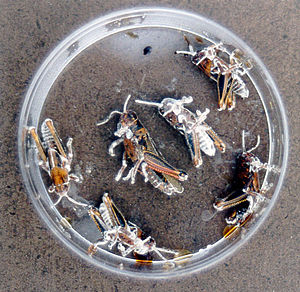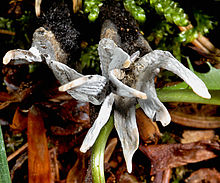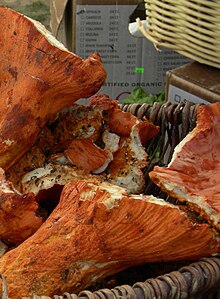Sordariomycetes
| Sordariomycetes | ||||||||||||
|---|---|---|---|---|---|---|---|---|---|---|---|---|

Beauveria bassiana on grasshoppers |
||||||||||||
| Systematics | ||||||||||||
|
||||||||||||
| Scientific name | ||||||||||||
| Sordariomycetes | ||||||||||||
| OEErikss. & Winka |
The Sordariomycetes are a class of mushrooms . With over 600 genera and over 3000 species, they are one of the largest classes of hose fungi. The majority of the species is characterized by perithecic , bottle-shaped fruiting bodies and inoperculate, unitunicate asci .
features
The majority of the species form perithecia as fruiting bodies , some groups also form celistothecia , probably through loss of the perithecia opening. The arrangement of the asci is usually basal or lateral in a hymenium . The predominant Ascus construction is inoperculate, thin-walled and unitunicat. Prototunicate asci have developed in species with insect or water dispersal of the spores. Real paraphyses only occur in the two subclasses Sordariomycetidae and Xylariomycetidae . The Hypocreomycetidae have lateral or centripetal pseudoparaphyses or no such structures. The asci usually form eight spores.
The class is rich in asexual forms ( anamorphs ). The anamorphs can be hyphomycetic or coelomycetic , with coelomycetes mainly occurring in Glomerellaceae and Diaporthales. Many species of the orders Ophiostomatales, Chaetosphaeriales and the crust spherical mushrooms (Hypocreales) form two or more different anamorphs.
Distribution and way of life
The Sordariomycetes are distributed worldwide, they colonize almost all habitats. They live as pathogens and endophytes in plants, arthropods and mammals, as mycoparasites on other fungi, and as saprobionts they play an essential role in the breakdown of organic material and in the nutrient cycle.
The plant pathogens occur especially in the orders Diaporthales, Hypocreales, Microascales, Ophiostomatales, Phyllachorales and the wooden club-like (Xylariales). Well-known representatives are the chestnut crayfish ( Cryphonectria parasitica ), the cause of Dutch elm disease ( Ophiostoma ulmi and Ophiostoma novo-ulmi ), Fusarium and Rossellinia species. Among the Sordariomycetes there are also endophytes that live in the aboveground parts of the plant, such as Balansia and Epichloe (crust ball-shaped mushrooms) , Nemania and Xylaria (Xylariales) and Colletotrichum . The host plants are more drought-resistant , suffer less from insect damage and are less likely to be infected by pathogens.
Species of the globular fungus, ophiostomatales, and microascales often cause opportunistic infections in humans and other animals. Examples are Sporothrix schenkii , Fusarium solani and Trichoderma . The symbioses with arthropods range from antagonistic to mutualistic. Spores from representatives of the Microascales and Ophiostomatales are spread by bark beetles ; Representatives of the spheroidal mushrooms parasitize on various arthropods. The spherical crustaceous fungi also produce a number of mycoparasites that parasitize on large, fleshy fruiting bodies.
As saprobionts they break down wood, herbaceous parts of plants and also dung - see also composting .
Bioactive substances are obtained from claviceps and epichloe , among others .
Several representatives have switched to an aquatic way of life (Halosphaeriaceae, Lulworthiales), including some inhabitants of salt water .
Systematics
The class has been found in phylogenetic studies to be a unified kin group, it is monophyletic . In Hibbet et al. (2007) the class had three monophyletic subclasses. The Sordariomycetes are the sister group of the Leotiomycetes . Maharachchikumbura, et al. (2015) divide the class into 6 subclasses, 28 orders, 90 families and 1344 genera. Up to the order, the system is as follows:
- Subclass Diaporthomycetidae
- Order Annulatascales
- Order Diaporthales
- order Cordanales
- Order Calosphaeriales
- Order Coniochaetales
- Order jobellisiales
- Order Ophiostomatales
- Order Togniniales
- Order Trichosphaeriales
- Order Magnaporthales
- Subclass Lulworthiomycetidae
- Order Lulworthiales (including Spathulosporales)
- Order Koralionastetales
- Subclass Savoryellomycetidae
- Order Conioscyphales
- Family Conioscyphaceae
- Order Fuscosporellales
- Fuscosporellaceae family
- Order pleurotheciales
- Pleurotheciaceae family
- order Savoryellales
- Savoryellaceae family
- Subclass Hypocreomycetidae
- Order Coronophorales
- Order Melanosporales
- Order Microascales (including Holosphaeriales)
- Order glomerellales
- Order spherical crusty mushrooms - Hypocreales
- Order Falcocladiales
- order Savoryellales
- Subclass Sordariomycetidae
- Order Chaetosphaeriales
- Order Phyllachorales
- Order Boliniales
- Order Sordariales
- Subclass Xylariomycetidae
- Order wooden club-like - Xylariales
- not assigned to any subclass - incertae sedis
- Order Amplistromatales
- Order Pisorisporiales
- Order Spathulosporales
supporting documents
Individual evidence
- ^ Spatafora et al .: A five-gene phylogeny of Pezizomycotina , 2006.
- ↑ DS Hibbett et al .: A higher-level phylogenetic classification of the Fungi. In: Mycological research, May 2007; III (5): 509-547. Epub 2007 March 13, 2007. doi: 10.1016 / j.mycres.2007.03.004 , (PDF; 1.28 MB)
- ↑ a b Sajeewa SN Maharachchikumbura, Kevin D. Hyde, EB Gareth Jones, Eric HC McKenzie, Shi-Ke Huang, Mohamed A. Abdel-Wahab, Dinushani A. Daranagama, Monika Dayarathne, Melvina J. D'souza, Ishani D. Goonasekara, Sinang Hongsanan, Ruvishika S. Jayawardena, Paul M. Kirk, Sirinapa Konta, Jian-Kui Liu, Zuo-Yi Liu, Chada Norphanphoun, Ka-Lai Pang, Rekhani H. Perera, Indunil C. Senanayake, Qiuju Shang, Belle Damodara Shenoy, Yuanpin Xiao, Ali H. Bahkali, Jichuan Kang, Sayanh Somrothipol, Satinee Suetrong, Tingchi Wen, Jianchu Xu: Towards a natural classification and backbone tree for Sordariomycetes . In: Fungal Diversity . tape 72 , 2015, p. 199-301 , doi : 10.1007 / s13225-015-0331-z .
- ↑ Thongkantha S., Jeewon R., Vijaykrishna, D., Lumyong, S., Mckenzie, EHC., Hyde, KD. 2009. Molecular phylogeny of Magnaporthaceae (Sordariomycetes) with a new species Ophioceras chiangdaoense from Dracaena loureiroi in Thailand. Fungal Divers 34: 157-173. Online via ResearchGate
- ↑ Sinang Hongsanan, Sajeewa SN Maharachchikumbura, Kevin D. Hyde, Milan C. Samarakoon, Rajesh Jeewon, Qi Zhao, Abdullah M. Al-Sadi, Ali H. Bahkal: An updated phylogeny of Sordariomycetes based on phylogenetic and molecular clock evidence . In: Fungal Diversity . tape 84 , no. 1 , 2017, p. 25-41 , doi : 10.1007 / s13225-017-0384-2 .
literature
- Ning Zhang et al .: An overview of the systematics of the Sordariomycetes based on a four-gene phylogeny . In: Mycologia , Volume 98, 2006, pp. 1076-1087.
- Joseph W. Spatafora et al .: A five-gene phylogeny of Pezizomycotina . In: Mycologia , Volume 98, 2006, pp. 1018-1028.


